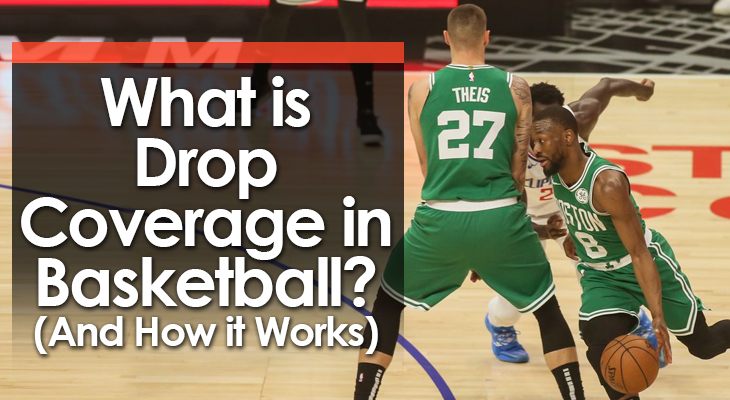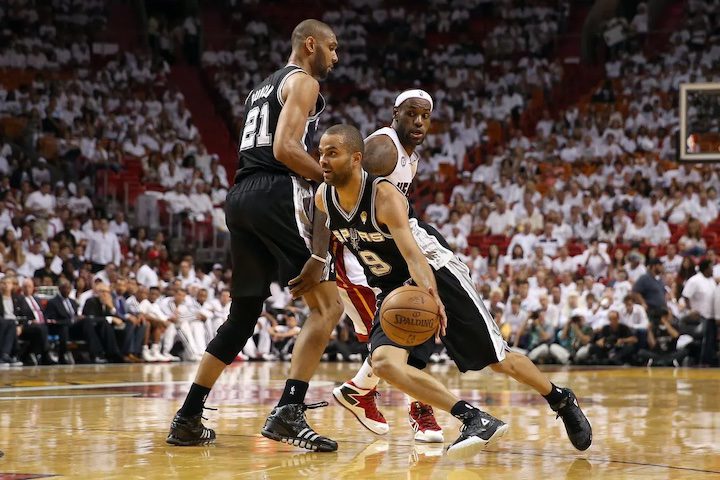What’s Drop Protection in Basketball? (And The way it Works)

[ad_1]

The pick-and-roll is extensively used throughout all ranges of basketball.
A method groups could select to defend it’s through the use of a method known as “drop protection“.
As drop protection soars in reputation, it’s essential for each coaches and gamers to know how this technique works and what every participant’s tasks are after they’re concerned.
Beneath, I will give a full breakdown of the way it works and when it is best to make use of it.
Let’s get began…
What’s Drop Protection?
Drop protection is a tactic to defend ball-screens, specializing in the screener’s defender.
When a ball-screen is used, the defender guarding the screener *drops* to a sure degree within the paint to stop / problem any photographs close to the rim.
The screener’s defender has two main tasks:
1. Hold the Ball in Entrance
Do not enable the ball-handler to get near the ring and take a simple shot.
2. Hold the Curler in Entrance
Do not enable the curler to get deeper than they’re, or threat a lob being thrown.
It feels like loads of work for the defender guarding the screener, however they are not alone.
The defender guarding the ball-handler goes over the display hoping to information the ball-handler to the drop defender whereas attempting to get again in entrance.
Going excessive of the display prevents the ball-handler from having the ability to shoot an uncontested pull-up or three-point shot.
The way to Execute Drop Protection
The idea of drop protection is pretty easy, but it surely isn’t all the time simple to execute.
The primary (and most essential) side of drop protection is communication.
All 5 guys on the ground must know what ball display protection to execute.
Which leads me to the 1st step…
#1 – Name Out the Display screen
When the defender guarding the screener notices they’ll set a ball display, they have to instantly let their teammate know a display is coming to provide them time to arrange.
It additionally helps to allow them to know which facet the display might be set on.
“Display screen left!” or “Display screen proper!”
#2 – No Rejections
The defender guarding the screener will work arduous to place themselves appropriately primarily based on the ball-handler utilizing the display.
The defender guarding the ball-handler can’t let the ball-handler reject the display or the protection gained’t be efficient.
#3 – Know The place to Go
Positioning is essential for the defenders concerned within the ball display.
a. On-Ball Defender
The on-ball defender should go excessive of the display to stop the ball-handler from “stopping and popping”.
They have to additionally try and get again in entrance of their defender as shortly as potential so the “drop defender” can get well again to their man.
b. Screener’s Defender
The defender guarding the screener must know the place to place themselves to stop the ball-handler from turning the nook, but in addition forestall the curler from getting beneath for a lob.
The offensive skill of each the ball-handler and the screener will dictate how far the defender ought to “drop” when utilizing drop protection.
There are loads of variables, so every participant should know the scouting report and coaches should ensure to drill this protection quite a bit earlier than utilizing it in a recreation.
#4 – Recuperate
As talked about above, the on-ball defender should get again in entrance as shortly as potential.
As soon as they’re capable of get well again, the screener’s defender can return and the protection is reset.
When to Use Drop Protection
Let’s shortly evaluate the quite a few methods you could select to protect a ball display:
Switching — One of the vital widespread methods groups guard ball-screens and possibly the best to implement. The defender guarding the ball-handler and the defender guarding the display will *swap* opponents when the display is executed.
Hedging — Hedging is when the screener’s defender momentarily steps out to defend the ball-handler, slowing down the ball and stopping penetration. Defenders then return to the gamers they had been initially guarding.
Double-Teaming — Additionally known as a blitz. That is when the screener’s defender and the on-ball defender double-team the ball-handler as quickly as they arrive off of the display.
Icing — Icing is a method to make use of in sideline pick-and-rolls. It forces the ball-handler to reject the display and retains them out of the center of the ground.
So…
With all of those completely different ball-screen coverages, when ought to drop protection be used?
Drop protection is simplest when taking part in towards a “large” who scores quite a bit within the roll motion on a pick-and-roll.
The screener’s defender dropping into the paint places themselves within the path of the curler, taking away fast scoring alternatives and making the cross extraordinarily troublesome.
Drop protection can also be good towards guards who prefer to penetrate and rating.
By hanging again, the guard will not have the chance to blow up by and rating a simple layup.

When NOT to Use Drop Protection
a. When the Screener is an Elite Shooter
Drop protection shouldn’t be used towards gamers who prefer to “pick-and-pop.”
You may be giving up a wide-open look because the screener’s defender stands flat-footed within the paint.
b. Towards Nice Midrange Shooters
One other time drop protection isn’t as efficient is that if the ball-handler has a very good midrange recreation.
As a result of the drop defender falls again into the lane, the ball-handler will get many alternatives to tug up from about 15 ft or shoot a long-range floater.
This can be a troublesome shot for many gamers, so it is not often a difficulty…
However should you play towards an elite midrange shooter, be careful for this.
c. Towards Spain Decide and Roll
The “Spain Decide-and-Roll” is a novel motion that entails an offensive participant setting a back-screen for the ball-screen screener after they set a ball display.
Within the case of drop protection, the dropping defender would get screened from behind, and the curler may have a possibility to get under and catch a lob on the rim.
Conclusion
Drop protection is used at each degree of basketball.
It is a protection the entails the screener’s defender dropping again into the paint to (a) forestall the curler getting simple scores, and (b) to pressure the ball-handler into troublesome mid-range photographs.
In the event you wished to find out how drop protection works and when to make use of it, now !
[ad_2]
Source_link




